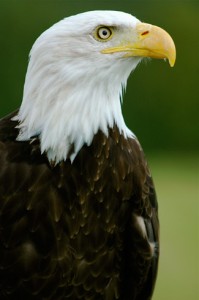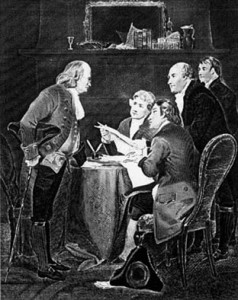
A Nation Takes Flight
Last week, I had the privilege of stepping back in time to the 1700s. A commanding presence of a man who said he was General George Washington told me it was 1781 — just before the invasion of Yorktown! And we were standing in the Wythe home in colonial Williamsburg after it was made headquarters for Washington and the Continental Army. George Wythe’s home, built in 1750, appeared much as it had back then, even down to some of the furniture being covered for protection during the building’s military use. George Wythe was a prominent attorney of the colonies and the mentor to Thomas Jefferson as he studied law for the bar. George Wythe was a signer of the Declaration of Independence and was considered the father of American jurisprudence.
When they could not agree, they enlisted the help of an artist who had knowledge of heraldry and designing seals, Pierre Eugène Du Simitière. He tried to incorporate all of their ideas into a design that went to Congress in August 1776. But, as you guessed, they tabled the matter until March 1780. This time they used another consultant, Francis Hopkinson. He was the designer of the American flag so he suggested that they use a design including a red and white stripe alternating pattern. Similarly, his seal design was tabled.
The third time, Congress appointed a committee that, in turn, appointed William Barton as the consultant. He was a lawyer and artist and suggested a small white eagle with spread wings. The eagle as he portrayed it, was to show with its stance the “symbol of supreme power and authority and signifies Congress.” At that point in history, the Continental Congress was both the executive and legislative branches of power–there was no president yet. As you would expect, the three formats of the proposed seals were further modified by Charles Thomson, the secretary of Congress.
 Thomson borrowed from all three designs to make his own. From Du Simitière he took the shield and the motto- E pluribus unum (one out of many). From Hopkinson, he used the alternating red and white stripes but put them on a shield of the eagle. Additionally, he used an olive branch and bundle of arrows each now placed in the talons to symbolize the nation’s love of peace but the readiness for war. Using Barton’s design, he used the eagle but transformed it into the native American Bald eagle, with wings extended downward in flight. Finally, about 6 years after the desire to have a seal representing the Continental Congress, there was one, with the eagle in the central and prominent position.
Thomson borrowed from all three designs to make his own. From Du Simitière he took the shield and the motto- E pluribus unum (one out of many). From Hopkinson, he used the alternating red and white stripes but put them on a shield of the eagle. Additionally, he used an olive branch and bundle of arrows each now placed in the talons to symbolize the nation’s love of peace but the readiness for war. Using Barton’s design, he used the eagle but transformed it into the native American Bald eagle, with wings extended downward in flight. Finally, about 6 years after the desire to have a seal representing the Continental Congress, there was one, with the eagle in the central and prominent position.
But not everyone was excited about the eagle representing this new nation. One of the outspoken critics of the use of the Bald eagle was Benjamin Franklin. He wrote his daughter in 1784, “I wish the bald eagle had not been chosen as the representative of our country. He is a bird of bad moral character. He does not get his living honestly. You may have seen him perch’d on some dead tree near the river, where, too lazy to fish for himself, he watches the labor of the fishing hawk; and when the diligent bird has at length taken a fish, and is bearing it to his nest for the support of his mate and young ones, the bald eagle pursues him and takes it from him. With all this injustice, he is never in good case but like those among men who live by sharpening and robbing he is generally poor and often very lousy.“ He goes on to write…”the turkey is …a more respectable bird, and withal a true original native of America… He is besides, tho’a little vain and silly, a bird of courage, and would not hesitate to attack a grenadier of the British guards who should presume to invade his farm yard with a red coat on.” I for one know that this is entirely true with my turkeys!
And as I walked the streets of colonial Williamsburg, I wondered what the town would really look like back then? Would there be throngs of Carolina parakeets chattering in the trees? Passenger pigeons out in the fields? I did notice a simple wood carving of a parrot-like bird that I presumed was a Carolina parakeet in one of the stores selling wares from that period. The Carolina parakeet (Conuropsis carolinensis) was the only parrot species native to the eastern United States. It was found from southern New York and Wisconsin to the Gulf of Mexico, and lived in old forests along rivers. Williamsburg itself is bordered by the York and James Rivers. The former river led to Yorktown, which Colonel Washington sieged to capture Britain’s Cornwallis and his forces. This parrot was the only species classified in the genus Conuropsis. It was called puzzi la née (“head of yellow”) or pot pot chee by the Seminole and kelinky in Chickasaw. It was known for its flocking behavior and I would think these lovely old live oaks along the streets of Williamsburg would make a great home for these social parrots. If only we had not trapped them to extinction. Yet, birds made their mark on Williamsburg and the founding of our country!





